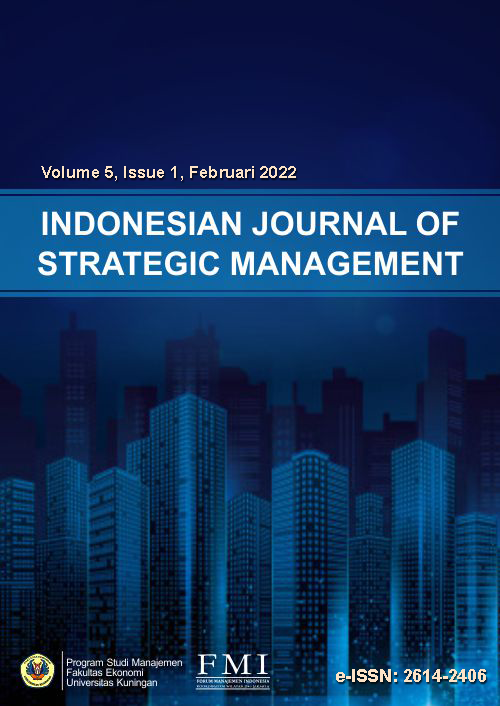Fintech P2P Lending dan Pengaruhnya Terhadap Pertumbuhan Ekonomi Indonesia
Abstrak
Previous research has shown that fintech contributes to GDP and reduces numbers and poverty. However, this does not cover the fact that P2P lending still has the potential to develop and have a positive impact on Indonesia's economic growth. This study examines the effect of P2P lending fintech on Indonesia's economic growth, using secondary data on Indonesia's economic growth from Bank Indonesia and P2P lending fintech data from the Financial Services Authority (OJK). Simple regression statistical analysis, t-test, and coefficient of determination show that peer to peer (P2P) lending has a positive and significant impact on Indonesia's economic growth. A total of 74.60 percent of the P2P lending variables explain the variables of Indonesia's economic growth. These results indicate that the growth of P2P lending is driving Indonesia's economic growth. This positive influence can be explained based on the relationship between P2P credit and other variables that affect the economy such as labor absorption variables through MSMEs, poverty rates, Gini ratio, GDP, growth of other economic sectors, household consumption levels, and inflation rates. This relationship is explained descriptively based on the results of previous studies.
Referensi
Adhinegara, B. Y., Huda, N., & Al Farras, I. (2018). Peran Fintech Lending Dalam Ekonomi Indonesia. Indef Monthly Policy Brief Edisi Riset Ekonomi Digital, 2(2), 1–4. http://indef.or.id/wp-content/uploads/2018/03/IMPACT-Volume-1-Issue-2-Maret-2018-E-Commerce-1.pdf
Alt, R., & Puschmann, T. (2012). The rise of customer-oriented banking - Electronic markets are paving the way for change in the financial industry. Electronic Markets, 22(4), 203–215. https://doi.org/10.1007/s12525-012-0106-2
Aprita, S. (2021). Peranan Peer to Peer Lending dalam Menyalurkan Pendanaan pada Usaha Kecil dan Menengah. Jurnal Hukum Samudra Keadilan, 16(1), 37–61. https://doi.org/10.33059/jhsk.v16i1.3407
Baihaqi, J. (2018). Financial Technology Peer-To-Peer Lending Berbasis Syariah Di Indonesia. TAWAZUN : Journal of Sharia Economic Law, 1(2), 116. https://doi.org/10.21043/tawazun.v1i2.4979
Benuf, K. (2020). Urgensi kebijakan perlindungan hukum terhadap konsumen. Rechts vinding, Media Pembina HUkum Nasional, 9(2), 203–217.
CGFS, G. C. on the G. F. S. (2017). FinTech Credit (Number May).
de Roure, C., Pelizzon, L., & Tasca, P. (2021). How Does P2P Lending Fit into the Consumer Credit Market? SSRN Electronic Journal, 30. https://doi.org/10.2139/ssrn.2848043
Fisabilillah, L. W. P., & Hanifa, N. (2021). Analisis pengaruh fintech lending terhadap perekonomian Indonesia. Indonesian Journal of Economics, Entrepreneurship, and Innovation, 1(3), 154–159. https://doi.org/10.31960/ijoeei.v1i3.866
Georgieva, K. (2019). IMF warns world growth slowest since financial crisis. BBC News. https://www.bbc.com/news/business-50047929
Harahap, B. A., Idham, P. B., Kusuma, A. C. M., & Rakhman, R. N. (2017). Perkembangan Financial Technology Terkait Central Bank Digital Currency (CBDC) Terhadap Transmisi Kebijakan Moneter dan Makroekonomi. Bank Indonesia, 2(2017), 1–80.
Herman, E. (2012). SMEs and Their Effect on the Romanian Employment. Procedia Economics and Finance, 3, 290–297. https://doi.org/https://doi.org/10.1016/S2212-5671(12)00154-2
Indayani, S., & Hartono, B. (2020). Analisis pengangguran dan pertumbuhan ekonomi sebagai akibat pandemi covid-19. Jurnal Ekonomi & Manajemen Universitas Bina Sarana Infoematika, 18(2), 201–208. https://ejournal.bsi.ac.id/ejurnal/index.php/perspektif/article/view/8581
INDEF, T. P. (2019). Studi Dampak Fintech P2P Lending terhadap Perekonomian Nasional. Institute for Development of Economics and Finance, 1–13. https://indef.or.id/update/detail/studi-dampak-fintech-peer-to-peer-lending-terhadap-perekonomian-nasional
Kohardinata, C., Soewarno, N., & Tjahjadi, B. (2020). Indonesian peer to peer lending (P2P) at entrant’s disruptive trajectory. Business: Theory and Practice, 21(1), 104–114. https://doi.org/10.3846/btp.2020.11171
Najaf, K., Subramaniam, R. K., & Atayah, O. F. (2022). Understanding the implications of FinTech Peer-to-Peer (P2P) lending during the COVID-19 pandemic. Journal of Sustainable Finance and Investment, 12(1), 87–102. https://doi.org/10.1080/20430795.2021.1917225
Nursini, N. (2020). Micro, small, and medium enterprises (MSMEs) and poverty reduction: empirical evidence from Indonesia. Development Studies Research, 7(1), 153–166. https://doi.org/10.1080/21665095.2020.1823238
Oh, E. Y., & Rosenkranz, P. (2020). Determinants of Peer-to-Peer Lending Expansion: The Roles of Financial Development and Financial Literacy (No 613; ADB Economics Working Paper Series).
OJK. (2022). Statistik Fintech Lending Periode Desember 2021. In Ojk.Go.Id (Vol 2021, bll 10–12). https://www.ojk.go.id/id/kanal/iknb/data-dan-statistik/fintech/Pages/Statistik-Fintech-Lending-Periode-juni-2021.aspx
OJK, D. K. (2018). Peraturan Otoritas Jasa Keuangan Republik Indonesia Nomor 13/POJK.02/2018 Tentang Inovasi Keuangan Digital di Sektor Jasa Keuangan. In Otoritas Jasa Keuangan (bll 1–38). http://www.ojk.go.id/id/kanal/iknb/regulasi/lembaga-keuangan-mikro/peraturan-ojk/Documents/SAL-POJK PERIZINAN FINAL F.pdf
Puschmann, T. (2017). Fintech. Business and Information Systems Engineering, 59(1), 69–76. https://doi.org/10.1007/s12599-017-0464-6
Putro, B. E., & Ilmaniati, A. (2020). The Effectiveness Model of Knowledge Sharing in Business Innovation to Improve the Performance of Micro Small and Medium Enterprises. Jurnal Ilmiah Teknik Industri, 19(1), 39–46. https://doi.org/10.23917/jiti.v19i1.10231
Rahma, T. I. F. (2018). Persepsi Masyarakat Kota Medan Terhadap Penggunaan Financial Technology (Fintech). At-Tawassuth, 3(1), 642 – 661. https://doi.org/10.30821/ajei.v3i1.1704
Rosavina, M., Rahadi, R. A., Kitri, M. L., Nuraeni, S., & Mayangsari, L. (2019). P2P lending adoption by SMEs in Indonesia. Qualitative Research in Financial Markets, 11(2), 260–279. https://doi.org/10.1108/QRFM-09-2018-0103
Rosyadi. (2019). Pengaruh Daya Beli dan Jumlah Pengangguran Terhadap Tingkat Kemiskinan di Indonesia Tahun 2012-2017. Prosiding SATIESP 2019, 45–55.
Santi, E., Budiharto, & Saptono, H. (2017). Pengawasan Otoritas Jasa Keuangan Terhadap Financial Technology ( Peraturan Otoritas Jasa Keuangan Nomor 77/Pojk.01/2016). Diponegoro Law Journal, 6(3), 1–20.
Saraswati, L. P. P. S. (2021). Peranan Perusahaan Penjaminan dalam Mengatasi Permasalahan UMKM Mengakses Kredit di Sektor Perbankan. Jurnal Hukum dan Pembangunan, 2(2), 512–522.
Savitri, A., Syahputra, A., Hayati, H., & Rofizar, H. (2021). Pinjaman Online di Masa Pandemi Covid-19 bagi Masyarakat Aceh. E-Mabis: Jurnal Ekonomi Manajemen dan Bisnis, 22(2), 116–124. https://doi.org/10.29103/e-mabis.v22i2.693
Simanungkalit, E. F. B. (2020). Pengaruh Inflasi Terhadap Pertumbuhan Ekonomi Di Indonesia. Journal of Management : Small and Medium Enterprises (SMEs), 13(3), 327–340. https://doi.org/10.35508/jom.v13i3.3311
Tambunan, T. (2011). SME Development in Indonesia: Do Economic Growth and Government Supports Matter? SSRN Electronic Journal, 1–19. https://doi.org/10.2139/ssrn.1218922
UNCTAD. (2020). Impact of the COVID-19 pandemic on trade and development: Transitioning to a New Normal. In United Nations Conference on Trade and Development.
World Bank. (2021). Domestic credit to private sector (% of GDP ) - Indonesia. Online. https://data.worldbank.org/indicator/FS.AST.PRVT.GD.ZS?locations=ID

